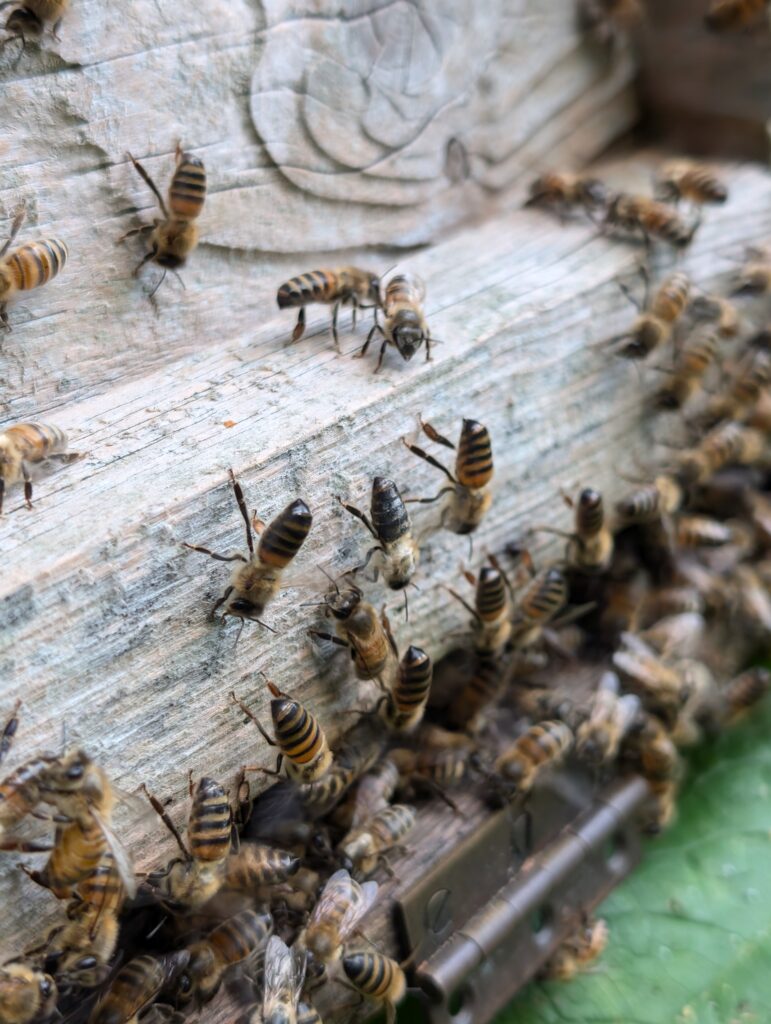Welcome to the Actual Honey miniseries where we discuss the different types of honey bee! Let’s start with the bee who is responsible for making the honey you enjoy: the worker.
In bee societies, all the workers are women. Because they are indispensable to the survival of the colony, worker bees form the overwhelming majority of the population, making them the most common sight inside and outside of the hive, so you’re probably familiar with how they look. They grow from fertilised eggs laid by the queen. A typical colony may have around 40,000 bees in the summer, so the queen has a lot of laying to do!
Despite being common, worker bees are exceptional. The loyalty and devotion of a worker bee to her colony is unparalleled. Every action she takes in life is for the benefit of her family. Let’s explore how that life progresses.
Upon emerging from her cell as a newborn, a worker bee will immediately get to work as a cleaner. She will inspect cells and clean them to a standard worthy of royalty! That’s because bees are highly hygienic and the queen requires spotless cells for laying her eggs. Human newborns tend to need a good meal, and a newborn worker bee is just the same. She dines on pollen chock-full of protein that will make her strong enough to face the challenges that lie ahead. As a worker bee ages and matures, the duties she performs change, so the challenges she takes on throughout her life are varied. But the overriding goal that motivates her every single day remains the same: to work for the good of the colony.
After 3 days of cleaning and eating pollen, the worker bee turns her attention to the stomachs of others: she becomes a nurse bee. This involves feeding older larvae a mixture of pollen and honey. Fascinatingly, it seems that her body soon recognises that she has become a nurse bee and responds by developing glands that can secrete the specific nutrition, known as royal jelly, required by younger larvae and queen larvae. So, for approximately 10 days, our worker spends her time feeding babies of all ages.

Well, that is the usual nurse bee role, but a few lucky girls win the prestigious honour of becoming a queen attendant! These ladies-in-waiting tend to all aspects of the queen’s wellbeing:
- They serve food to her.
- They keep her looking as spick and span as her royal highness ought to.
- They dispose of her waste since the queen is too busy laying eggs to take cleansing flights.
- They share the excellent news that the queen is happy and healthy by spreading her pheromones around the hive.
Whichever type of nurse she became, at around 13 days old she will change career from nurse to construction worker. This is triggered by the wax glands in her abdomen developing. The hexagonal combs, where baby bees grow and honey is stored, are built, repaired and sealed by the wax of construction worker bees. Additionally, she will greet her sisters when they return from foraging to collect the nectar and pollen they found and stash it in the cells she built.
After less than a week in this role, the worker bee takes up guard duty. She now has a functioning sting and strong mandibles (similar to pincers), so she is equipped to defend her home. This is the first of her tasks that is dangerous and could prove fatal, but she does not waver. When bees approach the hive, she will sniff them to ensure they carry the family aroma. If she suspects they are a drifter or robber, she will block the entrance. If the outsider persists, she will attack them. Using her sting will kill her but she is willing to do it for the sake of her colony.
A job that partners with this one involves standing at the hive entrance and wafting the family scent into the air to guide members of the colony back home.

During the days of working at the entrance of the hive, the worker bee will prepare for venturing out into the world by taking orientation flights, in which she comes to recognise the location of her home in the landscape. This leads to her final job: foraging.
At 21 days old, a worker bee becomes a forager. This job is tiring and hazardous but she will gather pollen, nectar, water and propolis for her colony until the day she dies. Assuming she isn’t killed by the dangers in the world, such as predators, our worker bee will probably die of exhaustion after 3 weeks.

The resources she gathers are essential to the survival of the colony. Pollen is their source of protein, used for raising brood. The nectar gathered from flowers is needed to produce honey, which provides them with energy and sees bees through the winter. Water is used to dilute the honey stores and cool the hive when it gets too hot. Propolis from trees is an antiseptic glue that can seal cracks in the hive, keeping it warm during cold seasons.
However, gathering these materials is the reason our worker bee does not survive. Every day she travels miles, lugging supplies back to the hive that can weigh as much as she does. Her wings become beaten and battered. This is why 6 weeks is the average lifespan of a summer worker bee.
The population of a colony drastically reduces during the winter, but some bees become winter workers. Their lifestyle is less brutal so they can live up to 6 months. You can read about their experiences here.
It’s fair to say that these bees thoroughly earn their title as ‘workers’. Every task not related to reproduction is completed by them and they spend every moment of their lives in servitude to their queen and colony.